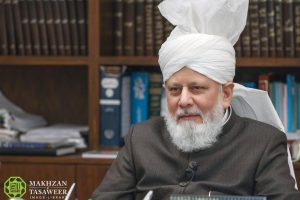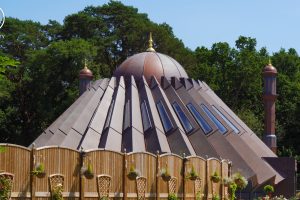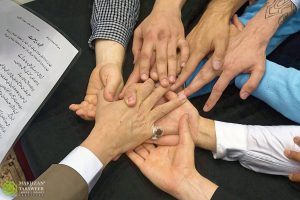
Sarah Malik, USA
Over a century ago, in a prayer duel with a false claimant to prophethood residing more than 11,500 km away in a city called Zion, Illinois, the Promised Messiah, Hazrat Mirza Ghulam Ahmad (as) of Qadian, India, proved victorious.
Now, a lustrous mosque shines bright in Zion, aptly called ‘The Mosque of the Grand Victory’, standing as a symbol of God’s unity and the Promised Messiah’s (as) victory.
Hazrat Mirza Masroor Ahmad (aba) Fifth Successor of the Promised Messiah (as) and Worldwide Head of the Ahmadiyya Muslim Community travelled to Zion to inaugurate this mosque. Ahmadi Muslims flocked to this hallowed site in order to take part in this historic event and of course, to be in the company of their beloved leader, His Holiness, the Caliph.
During the course of his stay in Zion, men, women and children alike would stand outside and brave frigid temperatures just to catch even a glimpse of His Holiness. The atmosphere was humming with voices of people sharing their stories of blessings and fulfilled prayers through the blessings of Khilafat (the Caliphate). Mothers could be overheard narrating the importance and history of Zion to their children, expressing awe that the Caliph was present in the very town from where Dr. Alexander Dowie sought to eradicate Islam.
We spoke with some ladies in Zion to find out their stories, sentiments, and feelings with the auspicious arrival of His Holiness (aba) for the inauguration of the Fath-e-Azeem Mosque.
Amtul Muid strolled the mosque grounds with an aura of positivity and an air of peace about her – surely, no one would guess that at home, her husband was struggling with brain cancer.
She had flown in from Atlanta, Georgia to serve on the ladies’ security team during His Holiness’s visit. Before departing, she wrote a letter to His Holiness (aba) about her husband being a brain surgery candidate. He’d undergone a battery of exclusions in hopes of being selected. ‘The very day that I came here to serve Huzoor’s [His Holiness’] security team my husband got a fax saying that he was selected for the surgery. I was just elated. So when I saw Huzoor, I’m thinking, thank you for your prayers!’ Amtul Muid emphasised her conviction that it was due to the prayers of her Caliph and her desire to be near him and serve him that led to their prayers to be answered.
Before His Holiness’ (aba) arrival, Sameera Iqbal was informed that only her daughter had been approved to meet with His Holiness. Sameera was overwhelmed with emotion at the thought that she wouldn’t be accompanying her daughter. With only an hour left until the private audience with His Holiness was scheduled, Sameera turned to the One Being who could give her peace, ‘I didn’t talk to anybody, I went straight to the mosque and I cried and stayed in sajda [prostration] and I asked Allah, “if You want me to meet your Khalifa [Caliph] You open the door for me, I’m not going to ask anyone else or request anybody to let me go.”’ When the time came, her daughter excitedly rushed Sameera towards His Holiness’ office, and by Allah’s grace, a last-minute decision was made by the administration, allowing her to attend the private audience with her daughter.

Ramla Walker Hakim, originally from Milwaukee, Wisconsin, converted to Islam Ahmadiyyat in 1996. Initially, she didn’t know much about the connection between Zion and Ahmadiyyat, but she always felt attracted to Zion and eventually moved to Zion. Her love for Zion was so strong that she named her grandson after the town, ‘I even named my grandson Zion, so my grandson got to learn about Zion and learn how to spell his name because he saw it everywhere.’ A Zion local she’d been volunteering all week.
As a high school teacher, Ramla noted that students weren’t taught about Zion’s ties to Islam and so she’s taken it upon herself to teach about Dr. Dowie, the Promised Messiah (as) and the connection this town has to Islam Ahmadiyyat. For her, it’s more than just teaching the history, it’s something she represents as the only person at the school who wears a headscarf. ‘I’m happy to be a convert’ she says, ‘because I’ve had that experience and I’m able to defend my position and Khilafat is a part of that.’
For Dhiya Bakr, not only does the inauguration of this mosque point to a bright future for the community in Zion, it’s the culmination of 22 years of effort, building relationships particularly with the non-Ahmadi people of Zion. ‘I keep saying it’s an unbelievable feeling and it’s like a miracle has happened and it’s like a chapter is closing and a new chapter opening.’ Dhiya expressed that now, she looks forward to the next generation taking up the task and carrying forth the mission and values which this mosque represents.
Pioneer Ahmadis like Nasira Raza felt a distinct sense of pride and fulfilment upon the inauguration of this mosque, as they’ve worked hard for years to see something like the inauguration of this mosque come to fruition. Nasira and her husband are known for being great teachers, having taught many new converts how to pray and recite the Holy Qur’an.
As it was for so many, the couple found it difficult being separated from people during the Covid-19 pandemic. But there was a silver lining, because it was during the pandemic that they decided to move to Zion, without any clue that soon, their beloved Caliph would be gracing the city. ‘I’m blessed and humbled to receive the Khalifa here today in our home and I now live 7 minutes away and I’m able to pray behind Huzoor every day and see him walk and it’s been a humbling blessing…It’s just so amazing.’
About the author: Sarah Malik, has a degree in Chemistry and is the recipient of the national American Chemical Society (ACS) award as the top student in the nation for her contribution to research and academic performance in Organic chemistry. Sarah has published and researched on her synthesis of a novel styrene polymer and on signalling pathways triggering GERD and oesophageal cancer. She is a team member of The Existence Project for The Review of Religions.




Add Comment